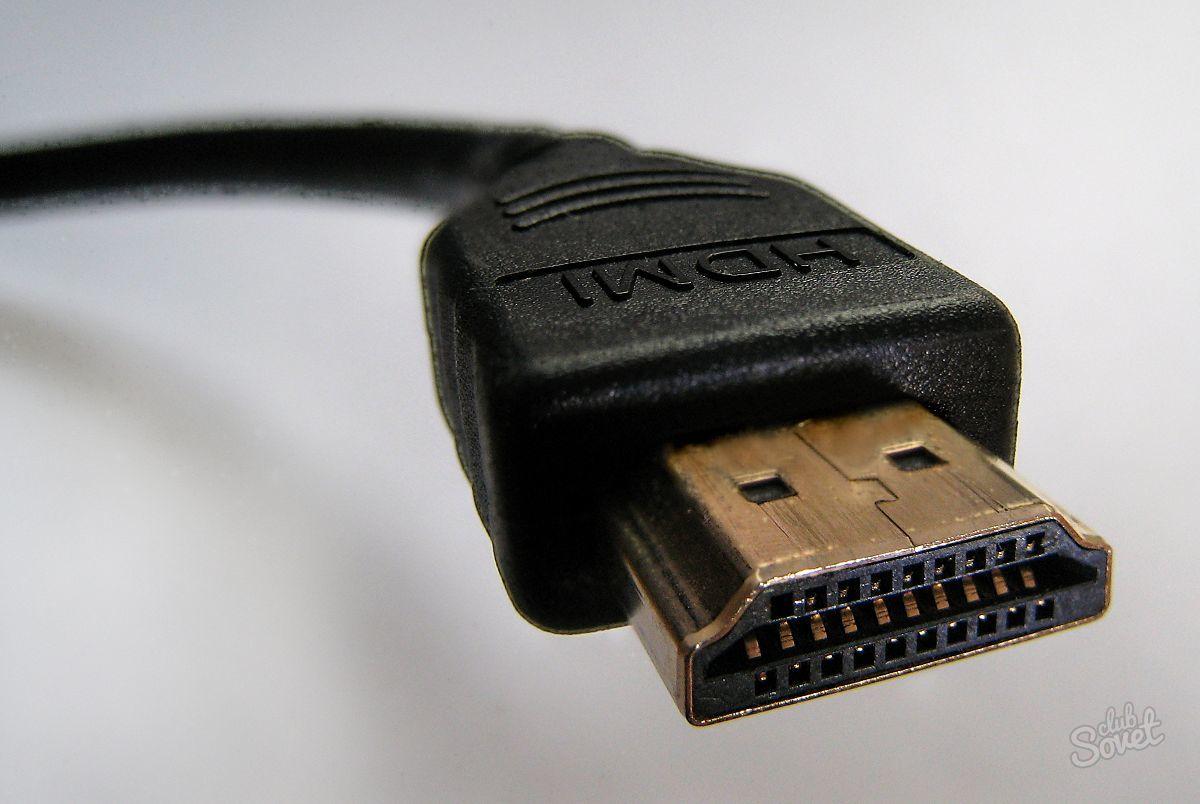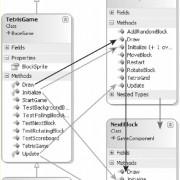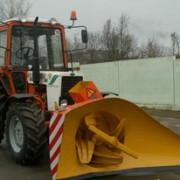Обозначения и расшифровка проводов магнитол
Содержание:
Phase locked loop basic concepts — phase
The key to the operation of a phase locked loop, PLL, is the phase difference between two signals, and the ability to detect it. The information about the error in phase or the phase difference between the two signals is then used to control the frequency of the loop.
To understand more about the concept of phase and phase difference, it is possible to visualise two waveforms, normally seen as sine waves, as they might appear on an oscilloscope. If the trigger is fired at the same time for both signals they will appear at different points on the screen.
The linear plot can also be represented in the form of a circle. The beginning of the cycle can be represented as a particular point on the circle and as a time progresses the point on the waveform moves around the circle. Thus a complete cycle is equivalent to 360° or 2π radians. The instantaneous position on the circle represents the phase at that given moment relative to the beginning of the cycle.
Phase angle of points on a sine wave
The concept of phase difference takes this concept a little further. Although the two signals we looked at before have the same frequency, the peaks and troughs do not occur in the same place.
There is said to be a phase difference between the two signals. This phase difference is measured as the angle between them. It can be seen that it is the angle between the same point on the two waveforms. In this case a zero crossing point has been taken, but any point will suffice provided that it is the same on both.
This phase difference can also be represented on a circle because the two waveforms will be at different points on the cycle as a result of their phase difference. The phase difference measured as an angle: it is the angle between the two lines from the centre of the circle to the point where the waveform is represented.
Phase difference between signals
When there two signals have different frequencies it is found that the phase difference between the two signals is always varying. The reason for this is that the time for each cycle is different and accordingly they are moving around the circle at different rates.
It can be inferred from this that the definition of two signals having exactly the same frequency is that the phase difference between them is constant. There may be a phase difference between the two signals. This only means that they do not reach the same point on the waveform at the same time. If the phase difference is fixed it means that one is lagging behind or leading the other signal by the same amount, i.e. they are on the same frequency.
Phase locked loop operation
The basic concept of the operation of the PLL is relatively simple, although the mathematical analysis and many elements of its operation are quite complicated
The diagram for a basic phase locked loop shows the three main element of the PLL: phase detector, voltage controlled oscillator and the loop filter.
In the basic PLL, reference signal and the signal from the voltage controlled oscillator are connected to the two input ports of the phase detector. The output from the phase detector is passed to the loop filter and then filtered signal is applied to the voltage controlled oscillator.
Phase locked loop diagram showing voltages
The Voltage Controlled Oscillator, VCO, within the PLL produces a signal which enters the phase detector. Here the phase of the signals from the VCO and the incoming reference signal are compared and a resulting difference or error voltage is produced. This corresponds to the phase difference between the two signals.
The error signal from the phase detector passes through a low pass filter which governs many of the properties of the loop and removes any high frequency elements on the signal. Once through the filter the error signal is applied to the control terminal of the VCO as its tuning voltage. The sense of any change in this voltage is such that it tries to reduce the phase difference and hence the frequency between the two signals. Initially the loop will be out of lock, and the error voltage will pull the frequency of the VCO towards that of the reference, until it cannot reduce the error any further and the loop is locked.
When the PLL, phase locked loop, is in lock a steady state error voltage is produced. By using an amplifier between the phase detector and the VCO, the actual error between the signals can be reduced to very small levels. However some voltage must always be present at the control terminal of the VCO as this is what puts onto the correct frequency.
The fact that a steady error voltage is present means that the phase difference between the reference signal and the VCO is not changing. As the phase between these two signals is not changing means that the two signals are on exactly the same frequency.
The phase locked loop, PLL is a very useful building block, particularly for radio frequency applications. The PLL forms the basis of a number of RF systems including the indirect frequency synthesizer, a form of FM demodulator and it enables the recovery of a stable continuous carrier from a pulse waveform. In this way, the phase locked loop, PLL is an essential RF building tool.
Next page
More Essential Radio Topics:Radio Signals
Modulation types & techniques
Amplitude modulation
Frequency modulation
OFDM
RF mixing
Phase locked loops
Frequency synthesizers
Passive intermodulation
RF attenuators
RF filters
Radio receiver types
Superhet radio
Radio receiver selectivity
Radio receiver sensitivity
Receiver strong signal handling
Return to Radio topics menu . . .
Phase locked loop, PLL applications
The phase locked loop take in a signal to which it locks and can then output this signal from its own internal VCO. At first sight this may not appear particularly useful, but with a little ingenuity, it is possible to develop a large number of phase locked loop applications.
Some phase lock loop applications include:
- FM demodulation: One major phase locked loop application is that of a FM demodulator. With PLL chips now relatively cheap, this PLL applications enables high quality audio to be demodulated from an FM signal.
- AM demodulation: Phase locked loops can be used in the synchronous demodulation of amplitude modulated signals. Using this approach, the PLL locks onto the carrier so that a reference within the receiver can be generated. As this corresponds exactly to the frequency of the carrier, it can be mixer with the incoming signal to synchronous demodulate the AM.
- Indirect frequency synthesizers: Use within a frequency synthesizer is one of the most important phase locked loop applications. Although direct digital synthesis is also used, indirect frequency synthesis forms one of the major phase locked loop applications.
- Signal recovery: The fact that the phase locked loop is able to lock to a signal enables it to provide a clean signal, and remember the signal frequency if there is a short interruption. This phase locked loop application is used in a number of areas where signals may be interrupted for short periods of time, for example when using pulsed transmissions.
- Timing distribution: Another phase locked loop application is in the distribution precisely timed clock pulses in digital logic circuits and system, for example within a microprocessor system.
Phase locked loop basics
A phase locked loop, PLL, is basically of form of servo loop. Although a PLL performs its actions on a radio frequency signal, all the basic criteria for loop stability and other parameters are the same. In this way the same theory can be applied to a phase locked loop as is applied to servo loops.
Basic phase locked loop basic diagram
A basic phase locked loop, PLL, consists of three basic elements:
-
Phase comparator / detector: As the name implies, this circuit block within the PLL compares the phase of two signals and generates a voltage according to the phase difference between the two signals.
This circuit can take a variety of forms. . . . . Read more about the phase detector . - Voltage controlled oscillator, VCO: The voltage controlled oscillator is the circuit block that generates the radio frequency signal that is normally considered as the output of the loop. Its frequency can be controlled over the operational frequency band required for the loop. . . . . Read more about the voltage controlled oscillator, VCO.
- Loop filter: This filter is used to filter the output from the phase comparator in the phase locked loop, PLL. It is used to remove any components of the signals of which the phase is being compared from the VCO line, i.e. the reference and VCO input. It also governs many of the characteristics of the loop including the loop stability, speed of lock, etc. . . . . Read more about the PLL loop filter.
Фразовые глаголы, образованные с глаголом Come
come about
to happen, or start to happenвозникать
How did the idea for an arts festival come about? Как возникла идея фестиваля искусств?
come across sb/sth
to meet someone or discover something by chanceвстретить или наткнуться на кого-либо/что-либо
I came across a lovely little restaurant in the village. Я наткнулся на прекрасный небольшой ресторан в деревне.
come along
to go somewhere with someoneпойти вместе
We’re going to the cinema. Do you want to come along? Мы идем в кино. Вы хотите пойти вместе?
to return to a placeвозвращаться
I’ve just come back from the dentist’s. Я только что вернулся от стоматолога.
come down
to fall or become lowerупасть или стать ниже
A lot of trees came down in the storm. Много деревьев упало в шторм.
Prices always come down after Christmas. Цены всегда становятся ниже после Рождества.
come down with sth
to become ill with (a sickness )заболеть чем-либо
Fred came down with the flu yesterday. Фред заболел гриппом вчера.
I hope his children don’t come down with it. Я надеюсь, его дети не заболеют этим.
come forward
to offer to help someone or to give informationвыступить в защиту, дать информацию
The police have asked any witnesses to come forward. Полиция попросила любых свидетелей выступить.
come from sth
to be born, obtained from, or made somewhereбыть родом, происходить, браться
She comes from Poland. Она родом из Польши.
Milk comes from cows. Молоко происходит от коров.
to enter a placeвойти
Come in and sit down. Входите и садитесь.
come off sth
to become removed from somethingстать удаленным от чего-то
The handle has come off this cup.Ручка оторвалась от этой чашки.
come on
to start to happen or workвключаться, начинаться
The heating comes on at six in the morning. Отопление начинается в шесть утра.
I think I have a cold coming on. Я думаю, у меня простуда начинается.
to make progressпродвигаться
How’s your new novel coming on? Как продвигается Ваш новый роман?
Come on! (informal)Давай!
Come on! We’re going to be late. Давай! Мы опоздаем.
come out
to appearпоявляться
The rain stopped and the sun came out. Дождь прекратился, и солнце вышло.
become availableвыходить (о книге, альбоме, фильме)
When does their new album come out? Когда их новый альбом выходит?
come up
to be mentionedбыть упомянутым
A number of interesting points came up at today’s meeting. Ряд интересных моментов упомянуто на сегодняшней встрече.
to be about to happen soonскоро должно произойти
We’ve got a busy period coming up in a couple of weeks. У нас напряженный период подойдет через пару недель.
come up against
be faced with or opposed by сталкиваться или противостоять
The project came up against a lot of criticism. Проект столкнулся с большой критикой.
come up with
to suddenly think of an ideaпридумать идею
The marketing department came up with a brilliant idea. Отдел маркетинга придумал блестящую идею.
Петля эффектов для примочек. Луперы
*Не путать с фразовыми сэмплерами/луперами а-ля Boss RC-20, Digitech JamMan и иже с ними. Эти педали предназначены для записи и цикличного воспроизведения отдельных фраз. Наши луперы совсем для другого.
Однако же есть и те ортодоксы, которые предпочитают пользоваться отдельными примочками и собирать из них свою собственную цепь. Им приходится труднее, так как количество различных манипуляций ногами, а зачастую и руками растет вместе с количеством примочек в цепи.
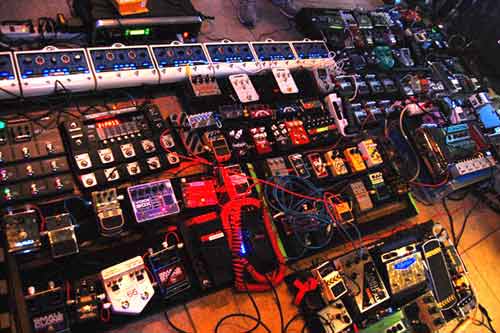
Рис.7. Много-много примочек
В конце-концов гитарист приходит к выводу, что у него скопилось слишком много примочек и управлять все этим хозяйством с каждой новой примочкой становится все сложнее и сложнее. Вот и приходится беднягам гитаристам танцевать джагу на эффектах практически на каждой репетиции.
Но и тут не все потеряно! Сократить количество переключений могут специальные девайсы: луперы (looper), от слова loop – петля, и лайн селекторы (line selector. Дословно – выбиратель линии), переключатели A/B, A/B/Y и т.д. и т.п. — названия могут быть разнообразны.
Суть, собственно, сводится к рассмотренному ранее принципу петель.

Рис.8. Looper
В простейшем случае (как на рис.8) устройство выполняет переключение сигнала с одной петли на другую, тем самый изменяя его путь от гитары до усилителя. Конечно, сейчас многие луперы снабжены различными бонусами в виде смешивания сигнала от обоих петель, возможностью байпаса, дополнительным выходом на тюнер и прочими функциями.
Есть луперы с тремя, четырьмя и более петлями, со сложной коммутацией петель, с программируемой коммутацией петель и тому подобное. Вот, например, такой сложный девайс делает Rocktorn.
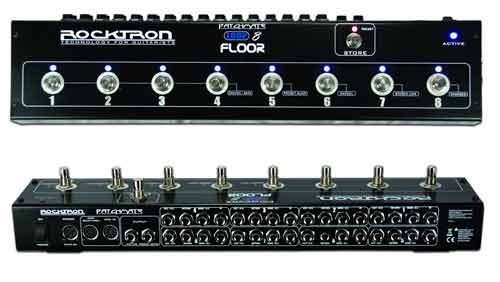
Рис.9. Rocktorn PatchMate Loop 8 Floor
А в скором времени выпуск подобного девайса планируется нашими сибирскими парнями из AMT.
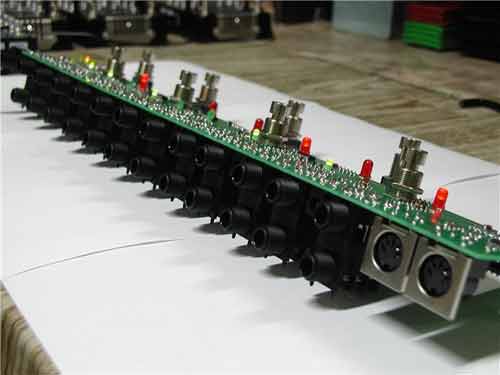
Рис.10. AMT TS-8 MIDI
Такие устройства позволяют запрограммировать путь сигнала через петли, и одним нажатием на кнопку менять количество и очередность включенных в данный момент петель.
В общем, если у вас большой педалборд, то лупер – это девайс из разряда «must have». Однако, будет ли это навороченный лупер с MIDI-управлением, типа Rocktorn PatchMate Loop 8 Floor или простой и, наверно, самый распространенный Line Selector Boss LS-2 – это уже решать вам, исходя из конкретных требований.
Думаю, что на этом закончу. Надеюсь, я достаточно подробно осветил все аспекты, касающиеся «разрывов» и «петель». В любом случае, дополнения, корректировки и вопросы приветствуются.
 
Дополнительные сведения:
jablog.ru
Разрыв в гитарном процессоре
Если раньше мы говорили, что разрыв в комбике обычно нужен для подключения эффектов модуляции, то в гитарных процессорах все с точностью наоборот. Тут в разрыв обычно включают всякие дисторшены\овердрайвы и прочие искажалки гитарного звука, не исключая и преампы.
Вот, например, как можно использовать петлю эффектов в гитарном процессоре Boss GT-10.
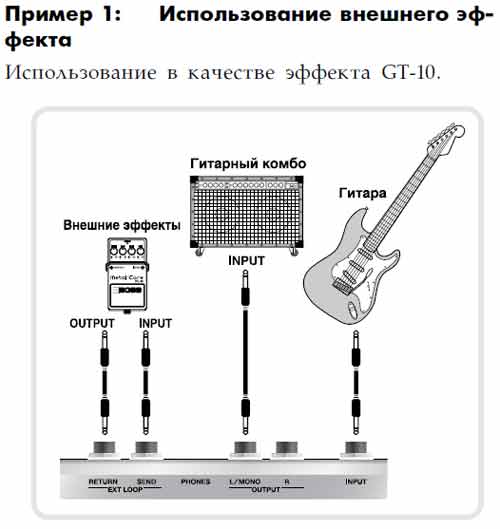
Рис.5. Использование разрыва в гитарном процессоре. Пример 1

Рис.6. Использование разрыва в гитарном процессоре. Пример 2
Есть мнение (хотя эта тема для отдельного холивара аналог VS цифра), что цифровая эмуляция перегрузов звучит не очень хорошо: мылит, тонет в миксе и т.п. Собственно, чтобы этого избежать, в разрыв процессора можно включить внешнюю искажалку звука. То есть, тут, вроде как, мы убиваем двух зайцев: получаем аналоговый перегруз и процессорное удобство управления.
Петля эффектов в комбике
Прежде всего, разберемся, из чего состоит стандартный комбоусилитель. А состоит он из секции преампа, сиречь предварительного усиления, и секции усиления, или оконечного усиления. Кстати говоря, комбо поэтому так и называется, что комбинирует в одном устройстве преамп и оконечный усилитель.
Дабы не загромождать рисунки, сразу оговоримся, что я не буду отображать сигнал поступающий на вход преампа. Нетрудно догадаться, что берется он там не магическим образом, а приходит от вашей гитары, и, возможно даже, через цепь эффектов, типа wah-wah или овердрайва, в общем, тех, которые нужно включать во вход преампа.

Рис.1 Комбик без разрыва
Так вот, «разрыв» – это разрыв между преампом и усилителем. Узнать о наличии в своем комбике петли очень просто: если сзади есть входы, подписанные SEND (посыл) и RETURN (возврат), то у вас разрыв определенно есть.
Разрыв бывает последовательный и параллельный (в этом случае как раз обычно и говорят про «петлю эффектов»). Давайте разберемся, в чем между ними разница.

Рис.2 Комбик с последовательным разрывом
В такой разрыв как правило включается цепь модуляционных эффектов (дилей, реверб, фэйзер и т.п.)
В логичности такого подхода можете убедиться своими ушами, для этого достаточно сначала нужно включить ту часть своей цепи эффектов, которая отвечает за модуляционные эффекты (пусть даже в ней всего лишь один дилей – это не важно) сначала во вход комбика, а потом проделать трюк, показанный на рис.2. Думаю, что разницу вы услышите невооруженным ухом
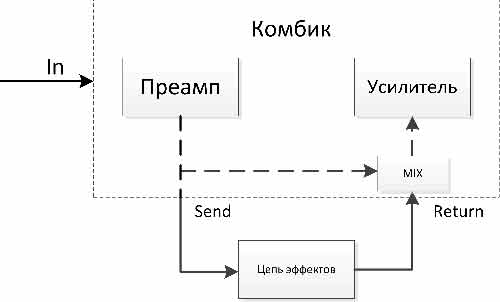
Рис.3. Комбик с параллельным разрывом
В случае с параллельным разрывом исходный сигнал после преампа делится на два: один идет на вашу цепь эффектов, а второй исходный, или говорят «сухой» сигнал поступает на вход встроенного в комбик мини-микшера. На второй вход этого мини-микшера поступает сигнал после вашей цепи эффектов. Уровень микширования двух сигналов обычно регулируется. Для этого в комбике с параллельным разрывом предусмотрен регулятор с надписью MIX.
С помощью параллельного разрыва можно смешивать обработанный и сухой звук в нужной вам пропорции. Причем зачастую в максимальном положении ручки MIX параллельный разрыв превращается в последовательный (однако, не всегда, но это, скорее, исключения из общего правила).
Некоторые примочки, обычно это дилеи и фэйзеры, могут работать по такому же принципу, то есть смешивать обработанный и сухой сигнал у себя на выходе, поэтому при включении таких примочек в параллельный разрыв могут возникнуть проблемы с фазой сигнала на входе RETURN комбика. Проще говоря, звучать все это может не очень хорошо.
Предвидя такой поворот событий, некоторые производители примочек, у которых есть эта фича, снабжают свои эффекты функцией с говорящим названием — Kill Dry. При включении этой функции с выхода примочки идет только обработанный сигнал, что позволяет использовать эти эффекты с параллельной петлей.
В общем, прежде чем покупать комбик с параллельным разрывом, неплохо бы проверить, как себя с ним поведут ваши примочки, а то мало ли чего…
Иногда бывает так, что в комбике есть только один вход – RETURN, а вот выхода SEND нет. Это говорит нам о том, что производители предусмотрели для нас возможность подключения своего гитарного преампа (например, AMT SS-11, Tubeman или любого другого), но лишили нас возможности пользоваться преампом и разрывом самого комбика. Что ж, определенная логика в этом есть, тем более что это удешевляет конструкцию.
Это нас плавно подводит к тому, зачем же делают петлю эффектов в отдельном гитарном преампе.
